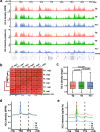Stable inheritance of H3.3-containing nucleosomes during mitotic cell divisions
- PMID: 35523900
- PMCID: PMC9076889
- DOI: 10.1038/s41467-022-30298-4
Stable inheritance of H3.3-containing nucleosomes during mitotic cell divisions
Erratum in
-
Publisher Correction: Stable inheritance of H3.3-containing nucleosomes during mitotic cell divisions.Nat Commun. 2022 Jun 20;13(1):3533. doi: 10.1038/s41467-022-31303-6. Nat Commun. 2022. PMID: 35725587 Free PMC article. No abstract available.
Abstract
Newly synthesized H3.1 and H3.3 histones are assembled into nucleosomes by different histone chaperones in replication-coupled and replication-independent pathways, respectively. However, it is not clear how parental H3.3 molecules are transferred following DNA replication, especially when compared to H3.1. Here, by monitoring parental H3.1- and H3.3-SNAP signals, we show that parental H3.3, like H3.1, are stably transferred into daughter cells. Moreover, Mcm2-Pola1 and Pole3-Pole4, two pathways involved in parental histone transfer based upon the analysis of modifications on parental histones, participate in the transfer of both H3.1 and H3.3 following DNA replication. Lastly, we found that Mcm2, Pole3 and Pole4 mutants defective in parental histone transfer show defects in chromosome segregation. These results indicate that in contrast to deposition of newly synthesized H3.1 and H3.3, transfer of parental H3.1 and H3.3 is mediated by these shared mechanisms, which contributes to epigenetic memory of gene expression and maintenance of genome stability.
© 2022. The Author(s).
Conflict of interest statement
The authors declare no competing interests.
Figures







Similar articles
-
POLE3-POLE4 Is a Histone H3-H4 Chaperone that Maintains Chromatin Integrity during DNA Replication.Mol Cell. 2018 Oct 4;72(1):112-126.e5. doi: 10.1016/j.molcel.2018.08.043. Epub 2018 Sep 11. Mol Cell. 2018. PMID: 30217558 Free PMC article.
-
Coordination of histone chaperones for parental histone segregation and epigenetic inheritance.Genes Dev. 2024 Mar 22;38(3-4):189-204. doi: 10.1101/gad.351278.123. Genes Dev. 2024. PMID: 38479839 Free PMC article.
-
How is epigenetic information on chromatin inherited after DNA replication?Ernst Schering Res Found Workshop. 2006;(57):89-96. doi: 10.1007/3-540-37633-x_5. Ernst Schering Res Found Workshop. 2006. PMID: 16568950 Review.
-
Replication-Coupled Nucleosome Assembly in the Passage of Epigenetic Information and Cell Identity.Trends Biochem Sci. 2018 Feb;43(2):136-148. doi: 10.1016/j.tibs.2017.12.003. Epub 2017 Dec 29. Trends Biochem Sci. 2018. PMID: 29292063 Free PMC article. Review.
-
The Mcm2-Ctf4-Polα Axis Facilitates Parental Histone H3-H4 Transfer to Lagging Strands.Mol Cell. 2018 Oct 4;72(1):140-151.e3. doi: 10.1016/j.molcel.2018.09.001. Epub 2018 Sep 20. Mol Cell. 2018. PMID: 30244834 Free PMC article.
Cited by
-
Mcm2 promotes stem cell differentiation via its ability to bind H3-H4.Elife. 2022 Nov 10;11:e80917. doi: 10.7554/eLife.80917. Elife. 2022. PMID: 36354740 Free PMC article.
-
Impaired histone inheritance promotes tumor progression.Nat Commun. 2023 Jun 10;14(1):3429. doi: 10.1038/s41467-023-39185-y. Nat Commun. 2023. PMID: 37301892 Free PMC article.
-
Characterization of histone chaperone MCM2 as a key regulator in arsenic-induced depletion of H3.3 at genomic loci.Toxicol Appl Pharmacol. 2023 Oct 15;477:116697. doi: 10.1016/j.taap.2023.116697. Epub 2023 Sep 20. Toxicol Appl Pharmacol. 2023. PMID: 37734572 Free PMC article.
-
Characterizing the Ovarian Cytogenetic Dynamics of Sichuan Bream (Sinibrama taeniatus) During Vitellogenesis at a Single-Cell Resolution.Int J Mol Sci. 2025 Mar 4;26(5):2265. doi: 10.3390/ijms26052265. Int J Mol Sci. 2025. PMID: 40076886 Free PMC article.
-
The cell-cycle choreography of H3 variants shapes the genome.Mol Cell. 2023 Nov 2;83(21):3773-3786. doi: 10.1016/j.molcel.2023.08.030. Epub 2023 Sep 20. Mol Cell. 2023. PMID: 37734377 Free PMC article. Review.
References
-
- Luger K, Mader AW, Richmond RK, Sargent DF, Richmond TJ. Crystal structure of the nucleosome core particle at 2.8 angstrom resolution. Nature. 1997;389:251–260. - PubMed
-
- Nakayam J, Rice JC, Strahl BD, Allis CD, Grewal SIS. Role of histone H3 lysine 9 methylation in epigenetic control of heterochromatin assembly. Science. 2001;292:110–113. - PubMed
-
- Peters AHFM, et al. Histone H3 lysine 9 methylation is an epigenetic imprint of facultative heterochromatin. Nat. Genet. 2002;30:77–80. - PubMed
Publication types
MeSH terms
Substances
Grants and funding
LinkOut - more resources
Full Text Sources
Molecular Biology Databases
Research Materials
Miscellaneous

